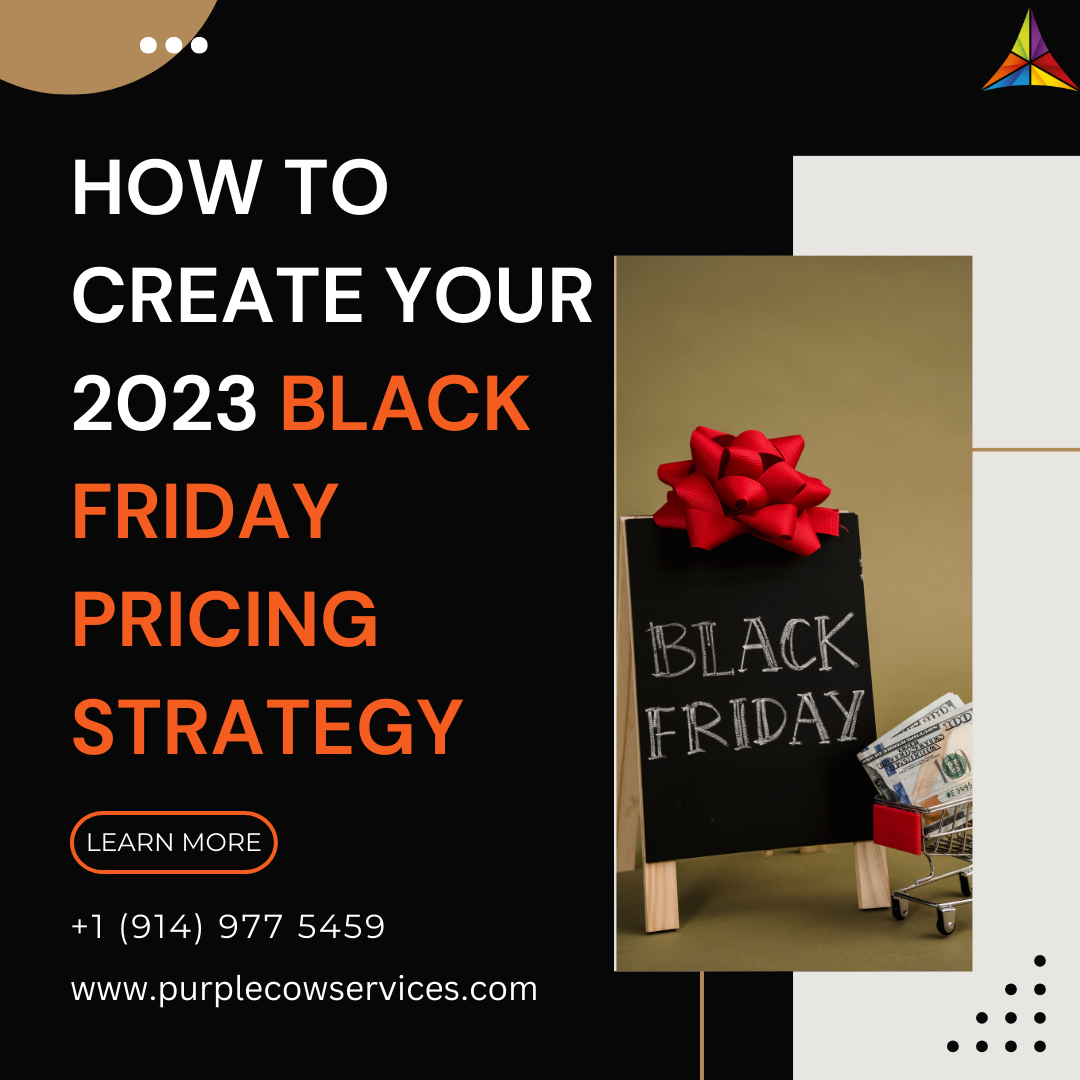Black Friday, the day after Thanksgiving, has become synonymous with shopping extravaganzas and incredible deals. It’s a date circled on calendars by both retailers and consumers alike. For businesses, it represents an opportunity to boost sales, clear excess inventory, and significantly impact their annual revenue. To make the most of this shopping phenomenon, crafting a well-thought-out pricing strategy is essential. In this blog, we’ll guide you through the process of creating your 2023 Black Friday pricing strategy.
Review Last Year’s Performance
Before diving into your Black Friday pricing strategy for 2023, it’s crucial to reflect on how your business fared during the previous year’s event. Analyze sales data, revenue generated, customer feedback, and any challenges you encountered. Understanding what worked and what didn’t will provide valuable insights for shaping this year’s strategy. Did certain products or promotions perform exceptionally well? Were there any logistical issues or customer complaints that need addressing?
Set Clear Objectives
Identify your primary objectives for Black Friday 2023. What specific outcomes are you aiming for? These objectives will serve as your guiding star when crafting your pricing strategy. Your goals could include:
- Increasing Revenue: Perhaps your main focus is boosting your Black Friday sales revenue compared to the previous year.
- Inventory Clearance: If you have excess inventory, your objective might be to clear it out by offering irresistible deals.
- Customer Acquisition: If you’re looking to expand your customer base, attracting new customers could be a primary goal.
- Brand Awareness: Maybe your aim is to enhance brand visibility and awareness during this peak shopping period.
- Customer Loyalty: You might want to reward your loyal customers and foster their continued loyalty.
Your pricing strategy should align closely with these goals to ensure you’re moving in the right direction.
Competitive Analysis
Study your competitors’ pricing strategies. What discounts and promotions did they offer during the previous Black Friday? Are they likely to offer similar products or services this year? This analysis will help you position your offerings competitively. It’s also an opportunity to identify any gaps in the market that you can capitalize on.
Pay attention to:
- Discount Levels: Assess how deeply your competitors discounted their products or services. Were they offering substantial discounts, and did it pay off in terms of sales and customer satisfaction?
- Product Selection: Note which products or services your competitors emphasized. Were there specific items that garnered more attention, and can you create similar interest in your offerings?
- Marketing Channels: Consider the marketing channels your competitors used to promote their Black Friday deals. Were they successful in building anticipation and excitement?
Understanding your competitors’ strategies can help you differentiate your own and potentially gain a competitive edge.
Inventory Management
Evaluate your current inventory levels. Identify which products or services you want to promote on Black Friday. Are there items that have been slow to move throughout the year? Consider creating bundles or exclusive deals to entice customers further.
Key considerations:
- Excess Inventory: Black Friday is an excellent opportunity to clear out excess or seasonal inventory. Determine which items are overstocked and could benefit from significant discounts.
- New Product Releases: If you plan to release new products shortly after Black Friday, consider using this event to generate buzz and clear the way for fresh inventory.
- Bundling Options: Bundle complementary products together to encourage customers to purchase more. For example, if you’re a technology retailer, offer a bundle with a laptop, accessories, and software at a discounted price.
The goal here is to ensure that your inventory aligns with your Black Friday pricing strategy and that you’re making room for new offerings.
Pricing Structure
Determine how you’ll structure your pricing for Black Friday. This decision will greatly impact how customers perceive your offers. Some common pricing structures include:
- Discount Percentage: Decide on the discount percentage you’ll offer on various products or services. Consider tiered discounts, where customers receive higher discounts for larger purchases.
- Buy-One-Get-One (BOGO): BOGO deals are popular because they encourage customers to buy more. For example, “Buy One, Get One 50% Off” can be an enticing offer.
- Doorbusters: Doorbusters are deeply discounted items available in limited quantities. These serve to draw customers into your store or website, with the hope that they’ll make additional purchases.
- Tiered Discounts: Reward customers for spending more by providing higher discounts on larger purchases. For example, “10% off $50, 15% off $100, and 20% off $200.”
Each pricing structure has its advantages, and you can even mix and match them to create a diverse set of offers that cater to different customer segments.
Communicate Early and Effectively
Start promoting your Black Friday deals well in advance. Building anticipation and excitement among your audience is key to a successful Black Friday. Effective communication channels include:
- eMail Marketing: Send out teaser emails, countdown emails, and exclusive offers to your email subscribers.
- Social Media: Utilize platforms like Facebook, Instagram, Twitter, and Pinterest to share sneak peeks, countdowns, and engage with your audience.
- Website: Create dedicated Black Friday landing pages on your website where customers can preview your deals.
- Paid Advertising: Consider running targeted paid advertising campaigns to reach a broader audience.
- In-Store Signage: If you have physical stores, ensure that your Black Friday promotions are prominently displayed.
Remember to highlight the value of your discounts and create a sense of urgency. Phrases like “Limited Time Offer” and “While Supplies Last” can encourage customers to act swiftly.
Monitor and Adjust
Once Black Friday is underway, closely monitor your sales, website traffic, and customer feedback. Be prepared to make real-time adjustments to your strategy if necessary. For instance, if a particular product isn’t selling well, consider increasing its discount or promoting it differently.
Key metrics to watch:
- Sales Conversion Rate: Are customers making purchases? Analyze the conversion rate on your website or in your physical stores.
- Website Traffic: Track the number of visitors to your website and identify which products or promotions are drawing the most attention.
- Inventory Levels: Keep an eye on your inventory to ensure that you have sufficient stock of popular items.
- Customer Feedback: Listen to customer feedback and address any issues promptly. Happy customers can become loyal ones.
- Competitor Moves: Keep tabs on your competitors’ last-minute promotions or changes in strategy.
Flexibility and adaptability are vital during this phase. A well-prepared team can make real-time decisions to optimize your Black Friday performance.
Post-Black Friday Analysis
After Black Friday concludes, it’s time to conduct a comprehensive analysis of your performance. This post-event assessment will provide valuable insights for refining your future pricing strategies. Consider the following:
- Goal Achievement: Compare your actual results to the objectives you set at the beginning. Did you meet or exceed your goals? If not, what areas need improvement?
- Product Performance: Identify which products or services performed exceptionally well and why. Was it the discount percentage, marketing, or other factors?
- Customer Behavior: Analyze customer behavior during Black Friday. Did they respond to specific promotions or pricing structures? Did you acquire new customers?
- Inventory Clearance: Evaluate how successful you were in clearing excess inventory and whether this positively impacted your bottom line.
- Marketing Channel Effectiveness: Measure the effectiveness of each marketing channel you used. Which channels generated the most engagement and sales?
Use the data and insights gathered to inform your future pricing strategies, not only for Black Friday but for other events and promotions throughout the year. The goal is continuous improvement based on a thorough understanding of your customers and market dynamics.
Conclusion:
Crafting a successful Black Friday pricing strategy for 2023 requires careful planning, analysis, and adaptability. By reviewing past performance, setting clear objectives, analyzing the competition, managing inventory, and effectively communicating your deals, you can maximize your revenue and create a memorable shopping experience for your customers. Stay agile, monitor results, and remember that a well-executed pricing strategy can set the stage for a prosper ous holiday season and beyond. With strategic planning and execution, your Black Friday can be a resounding success.
Unlock Black Friday Success with Purple Cow! Our strategic eCommerce Solutions is your key to record-breaking sales this 2023. We analyze your past performance, set clear goals, and craft irresistible offers. From discount structures to dynamic marketing, we’ve got you covered. Don’t miss out on the biggest shopping day of the year – choose Purple Cow for a Black Friday that stands out!














